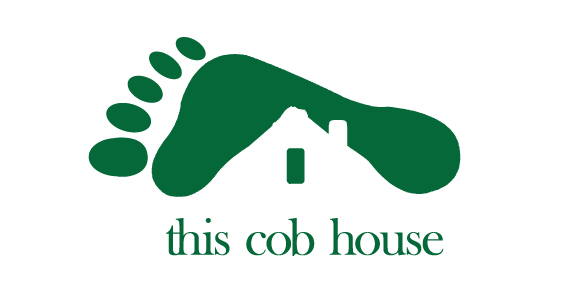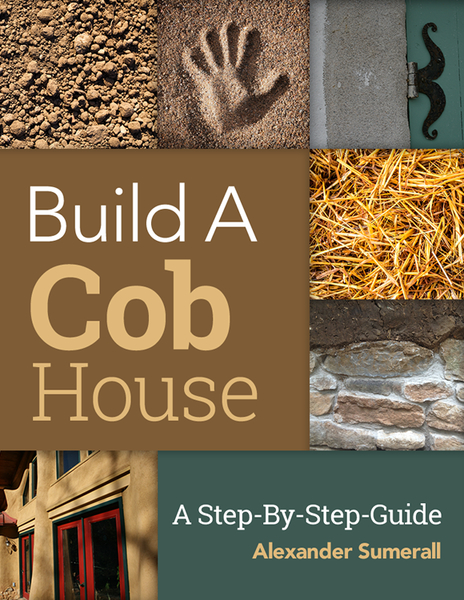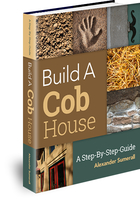Beginnings of Earth Building Techniques
Earth building techniques have been around for thousands of years. Since before our recorded history, people have been using the earth to build with. That’s why I tell people that earth building techniques are nothing new. In fact, they are very ancient. Today, the first-world, “developed” nations are just having a revival of these age-old methods of building. Some thirty percent of the world’s population currently lives in homes built out of earth. Through history, earth architecture has traveled all around the world.
Consider the earth constructions at Jericho in the Jordan Valley which date back to the tenth millennium B.C. Or the sections of the Great Wall of China which were built with rammed earth. There is an incredible amount of history and knowledge for us to rediscover which can be applied to the future of building.
Earthen Architecture for the Future
Many creative architects and builders are now constructing earthen buildings with these ancient methods. Some are teaching impoverished nations to build inexpensive, efficient, and beautiful earth buildings. Others are introducing these building techniques to the wealthier mechanized and developed nations.
With earth architecture, we don’t have to abandon everything that we currently build with. We can just take these methods from the past and move them into the future while replacing what makes most sense. It must make us raise the question though: What are the things to keep and the things to abandon?
Advantages of Earth Buildings
There are several important advantages to earth buildings. These advantages apply across the board for: cob, mud brick (adobe), rammed earth, as well as superadobe (earth bag) construction.
Low Materials Cost
The raw materials required for earthen building are widely available around the world at little to no cost. (Soil, Sand, Straw, Water) Earthen building materials also don’t require any high energy processing or manufacturing activities like wood, cement, and fired bricks do.
Despite the cost of the materials being low, prices for earthen buildings vary dramatically around the world. Luxury earthen homes in the American southwest can cost hundreds of thousands or even millions of dollars. At the low end of the price spectrum, somewhere on the other side of the world, you might be able purchase a smaller earthen dwelling for about the cost of your Starbucks latte and afternoon meal.
Earthen construction is perfect for the do-it-yourself builder though. The material cost is low, and there is usually very little outside labor that has to be paid for. An electrician and plumber may be necessary for some help on the job, but otherwise you can do the vast majority of the labor on your own. If you put in the labor to build with earthen materials then you will save a considerable amount of money.
Interior Temperature Regulation
Soil from the earth has proven to be a very suitable and successful building material throughout the world’s many climates because of its ability to regulate indoor temperatures. Earth is a poor conductor of heat, has low thermal conductivity, and has high thermal mass.
This topic is discussed more in depth in our online classroom.
Beauty
Earth buildings have been constructed all around the world and have many unique styles. They tend to be more attractive and colorful compared to their counterparts built with wood, stone, or fired brick.
Flexibility and Strength
The plasticity of earth materials allows for decorative ornamentation and roundness of corners and openings giving a soft feeling.
When dry, earthen buildings are extremely strong and durable resembling that of stone. Fortifications used to be made with these materials because they were so strong. Bullets can barely penetrate a thick earthen wall and they are nearly impossible to dig through.
The strength comes from the density of the soil under compression. This density also makes earthen walls soundproof. We also can’t forget to mention, earthen walls are fireproof too!
Earthen buildings have lasted intact for thousands of years. There are also cob homes in the United Kingdom that are hundreds of years old.
Cob (Layered Mud)
The word cob is derived from Southwest England, and is known by other names around the world. In the Middle East, South and Central Asia it is referred to as layered mud. This term describes the material and building process quite well. Cob is basically globs of doughy, mud material that is stacked and compressed on top of itself in layers to create structures.
Cob is a combination of clay-rich soil, aggregate (sand), straw (fiber), and water. The ingredients are mixed together into a stiff, dough-like consistency that can then be easily stacked and molded.
Cob buildings are known for their thick walls and rounded sides and corners. The material gives the builder a lot of flexibility in design. It’s a lot like sculpting and shaping a building out of clay as a sculptor would form a model.
Another architectural feature of cob walls is the gradual thinning as the walls rise from bottom to top. This reduces the weight at the top and reduces the risk of leaning or collapse from being too top-heavy.
History
Cob, or whichever name it goes by in a specific region of the world, is as ancient as building itself. The material has been used across most of the globe since the materials are readily and locally available in most places.
Cob, or layered mud, has been used through history to construct all types of structures: homes, shops, fortresses, government buildings, mosques, walls and fortifications.
Cob buildings have been known to last for hundreds of years, though not for as long as their related mud brick and rammed earth structures. The greater compression of mud brick and rammed earth gives them better resistance to erosion than cob.
Cob Building Technique
Cob buildings are constructed in layers. Each layer is built, set to dry, and then the next layer is built on top of that. There are no forms used to build walls with this method either. The cob is simply laid, compacted with hands or feet, and trimmed to the desired shape.
Old and Recent Examples
There are still thousands of cob homes and farm buildings in Devon, United Kingdom that date back from the 14th century to the 19th century. Cob buildings can easily last for several hundreds of years if maintained. Maintenance requires keeping the roof, foundations, and plasters in good condition to protect the cob structure from moisture.
There have been many new cob buildings constructed lately with the resurgent interest in earth architecture. For one example, Kevin McCabe, a UK cob enthusiast, has been building several large cob homes in England. He’s even constructed a 10,000 square foot cob “citadel”!
Advantages and Disadvantages of Cob
Advantages:
- Low cost for materials
- Simple, easy to learn, requires little or no experience
- Produces beautiful buildings
- Strong and sturdy
- Long lasting
- High thermal mass
Disadvantages:
- Labor intensive
- Slow building process
- More subject to cracking than other earth building techniques
- Lacks the convenience of modular bricks or forms
- Poor insulation value
Click here to learn more about cob building techniques.
Rammed Earth

Rammed earth or “beaten earth” is a fairly simplistic building technique but it can produce some of the grandest earthen buildings. It has been used on five continents and continues to be used in Australia, China, France, Germany, Morocco, South America, and it is having a small revival in the United States.
History
People have been building with packed dirt for nearly 10,000 years. Rammed earth has one of the longest and most successful histories as a building technique. It has even produced some of the largest and most elaborate earthen buildings.
Rammed earth dates back to the time of the pharaohs of Egypt and had its roots in North Africa and the Middle East. It also dates back about 5000 years in Asia with parts of the Great Wall of China. The Romans also used rammed earth throughout much of Europe.
Rammed earth construction is still practiced around the world to this day and is appropriate for a variety of climates.
Rammed Earth Building Technique
The first step to building rammed earth walls is to erect wooden or steel forms. These forms are very similar to what are used for concrete foundation work. Once the forms are set, moistened dirt is then put inside. The dirt may have sand added to it. These days, cement is also sometimes added to give it extra durability and to meet certain code requirements.
In certain parts of the world, forms were not used in ancient times. Some fortifications were built this way.
Once the material is put into the form it is tamped down and compacted with any of a variety of hand tools or power tools. After this, the next layer of material is added and tamped. This process repeats until the form is filled. After this, the forms are removed and the rammed earth wall remains.
Old and Recent Examples
There are several examples of ancient and new rammed earth buildings around the world.
One of the most recognized rammed earth structures is the Great Wall of China. Certain portions of the Great Wall were built with rammed earth. The western stretches of the Great Wall extended into the arid climate of the Gobi desert. This region’s resource scarcity likely presented rammed earth as a primary building method.
Recent examples of rammed earth construction can be found on many continents. There are many rammed earth buildings in France and Germany that were built in the nineteenth century.
There is even a 100-room, four-story resort hotel constructed out of rammed earth in Queensland, Australia.
Advantages and Disadvantages of Rammed Earth
Advantages:
- Low cost for materials
- Requires minimal water
- Straight-forward method of construction
- Produces beautiful buildings
- Suitable for building load-bearing, free-standing columns
- Strong and sturdy
- Long lasting
- Environmentally friendly
- High thermal mass
Disadvantages:
- Labor intensive
- Poor insulation value
- Not suitable for vaults and domes
Adobe (Mud Brick)

Adobe blocks are probably the oldest manufactured building material. This method of building is ancient, like rammed earth, and has been used almost everywhere in the world through history.
Adobe, also known as mud brick, is a building block composed of mud that is dried inside of wooden forms by the heat of the sun. The mud used comes from subsoil that contains clay and sand. The amounts will vary in every geographical location so its best to test your soil. You can add sand into the mixture if need be. Chopped straw is also included sometimes to help prevent cracking.
The word adobe actually refers to the bricks, the mortar, and the earthen plaster that covers it. This understanding is derived from the Spanish word adobar, and may not carry the same meaning in other parts of the world where adobe is called by other names.
History
Adobe structures in Egypt, the Mediterranean, and the Near East date back to about 5000 B.C. Much of the knowledge of this technique disseminated from these regions.
Mud brick has been used from ancient times right into the present for all types of buildings. However, modernization has continued to push this building technique away in many countries with replacements such as concrete and fired brick.
Adobe Building Technique
Adobe bricks are stacked with a running bond to create walls. The bricks are cemented together with a mud mortar. The size of an adobe brick varies from one region of the world to another.
Adobe buildings begin at the corners, and then the first layer of bricks is placed on top of the foundation. Mud mortar is placed on top of the first brick layer, and the next layer is set on top of this in a running bond formation. Having running vertical joints is significantly weaker.
Old and Recent Examples
Adobe is suitable for a wide variety of climates (It does not have to be an arid region), and it works for a variety of architectural styles too. From one room dwellings to multi-story palaces, and just about any other type of building you can imagine, adobe is suited.
There are a number of old and new examples of adobe buildings throughout the world.
Some of the most magnificent mud brick buildings are the tower homes of Shibam, Yemen. These buildings, made of mud bricks, rise 5 to 11 stories in height. There are about five hundred of them in the city of Shibam. Most of them were built sometime around the 16th century and they are still lived in by the people there today.
For modern examples of adobe buildings, just look to the American Southwest. There are adobe homes throughout the United States, but adobe has been popular in the Southwest because of its Spanish architectural influences and traditions of use there.
Advantages and Disadvantages of Adobe
Advantages:
- Low cost for materials
- Modular brick form
- Suitable for almost all types of buildings
- Good for do-it-yourself builders
- Strong and sturdy
- Long lasting
- High thermal mass
Disadvantages:
- Requires extra steps: molding, drying, and transporting of bricks
- More time consuming than most other earth building methods
- Need to make bricks or buy them
- Poor insulation value
- Not monolithic like cob and rammed earth
Wattle-and-Daub
Wattle-and-daub is a simple earth building technique that has been around for many millennia. Today, wattle-and-daub is found in use mostly in South Asia, and Africa. It had its time in Europe as well, but it is not used there anymore except sometimes for the infill of traditional timber frame buildings.
Wattle-and-daub walls tend to be much thinner than those of other earthen building methods. A wall basically consists of a thin lattice with mud packed onto both sides of it. This thinner wall means that it has less thermal mass.
History
Wattle-and-daub has had its place as a building technique all around the world: Europe, Africa, the Middle East, Asia, and the Americas. Ancient Mesopotamia, Rome, and many other ancient peoples used this technique for quick building. Because of its faster construction, many nomadic people also used wattle-and-daub to erect temporary dwellings.
Wattle-and-Daub Building Technique
This earthen building technique involves pressing mud into a woven lattice of sticks, bamboo, boards, or reeds. The mud can sometimes contain extra sand or fiber depending on the needs of the local soil.
The mud is mixed to a dough-like consistency and applied onto the lattice. A wattle-and-daub building can be done with just a few workers. It requires somebody to mix the mud and somebody to apply it to the walls. The process can be sped further with the help of a mixing machine.
Old and Recent Examples
Wattle-and-daub is not used frequently in the developed nations today. It has certain applications, but it is not often used exclusively to build whole homes with. It is more often used for interior walls or as infill between timbers.
There are plenty of examples from the past. Wattle-and-daub has mostly been used for small buildings and privacy walls.
Advantages and Disadvantages of Wattle-and-Daub
Advantages:
- Low cost for materials
- Quicker to construct with
- Good for small structures
- Structural flexibility adds to earthquake resistance
- Lightweight
Disadvantages:
- Poor insulation value
- Low thermal mass
- Not monolithic like cob and rammed earth
- Better suited for tropical climates (warm to hot)
- Rotting can occur in the lattice if open to water exposure
- Not load-bearing for heavy roofs
- Difficult to make additions or second stories
Superadobe (Earthbag)
Superadobe, also known as earthbag building, is a patented building method developed by Iranian architect Nader Khalili. It uses sand bags (polypropylene bags) filled with soil and compacted. Superadobe buildings employ arches, domes, and vaults regularly.
History
The superadobe system was developed by Nader Khalili in 1984, but similar methods have been used before that time. It was common for buildings to be constructed out of sand bags on the fields of war, starting before World War One.
Today, the superadobe system has developed into a sophisticated and modern building system fit for all types of needs. Interest in the system has continued to grow over the past few decades.
Superadobe Building Technique
Superadobe is built by filling polypropylene tubing or bags with a mixture of soil, sand, and sometimes cement. The bags are tamped to compression. A loop of barbed wire is placed between each layer of filled bags for tensile strength.
Old and Recent Examples
The superadobe (earthbag) method of building is a fairly recent invention, and does not have a long history. Some of the best examples of old would be the sandbag bunkers of World War One.
Today, you can find superadobe buildings around the world: United States, Canada, Mexico, Brazil, Belize, Costa Rica, Chile, Iran, India, Siberia, Mali, and Thailand.
Advantages and Disadvantages of Superadobe
Advantages:
- Low cost for materials
- High thermal mass
- Great for domes, arches, and vaults
- Strong and sturdy
Disadvantages:
- Poor insulation value
- Not monolithic
- Labor intensive
Conclusion
Now that you’ve had a glimpse at all of these earthen building techniques, you can begin to think about what methods you may want to use. Start by weighing the advantages and disadvantages of each method against the wants and needs for your building.
Different building techniques can be employed for different needs. For example, you could decide to build the exterior walls with cob and complete the interior (non load-bearing) walls with wattle-and-daub. There are many combinations that could be done. Use the systems to their specific advantages.
Earthen building techniques have been successful throughout history. They have passed the tests of time and they have proven to be reliable and practical for most cases. The main resource that you need to build with these systems is right beneath your feet. All we have to do is learn to use it again.






